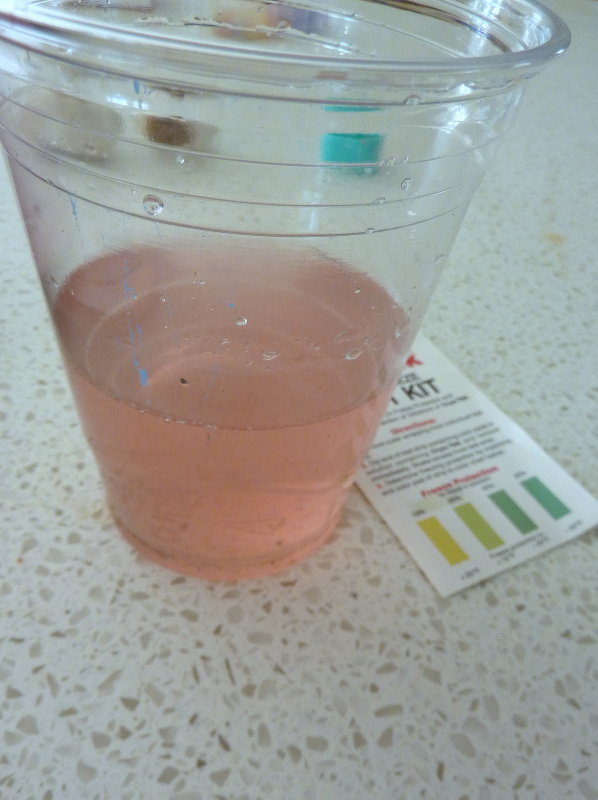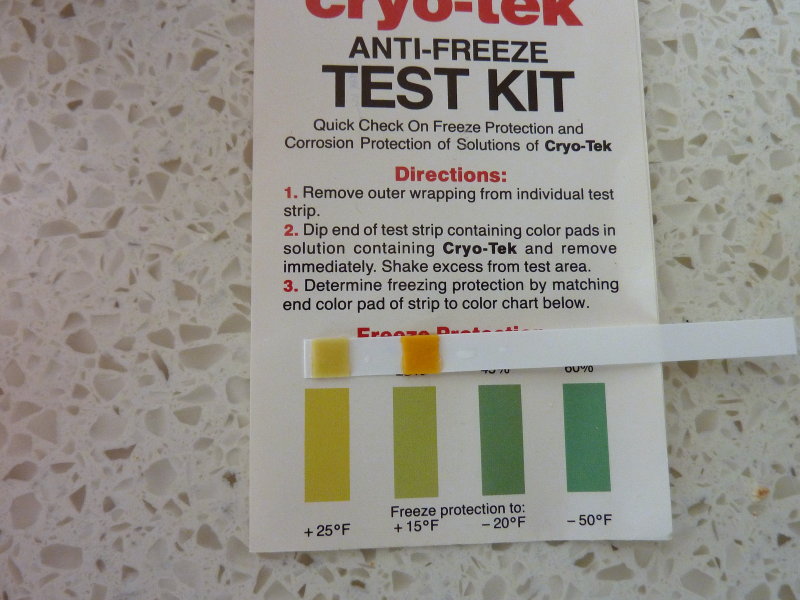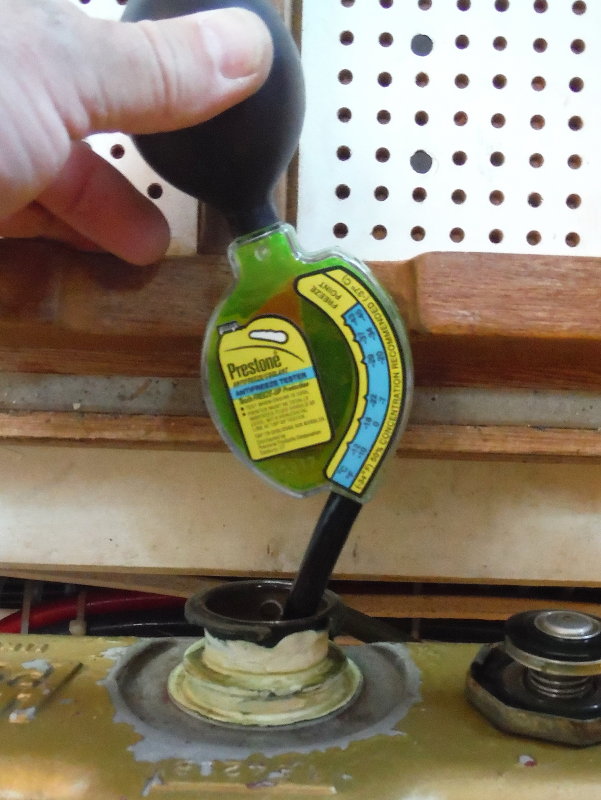This Came Out of a Boat Stored Winters in Maine

I got a call from a customer who felt his motor was running a little hot in the fall and thought he should address it during the off season. We decided to pop the caps off the heat exchanger, check it out, and take it from there.
I popped off the heat exchanger caps on a warm Maine early spring day and wow. The first thing I noticed was a very diluted color, of the propylene glycol in the heat exchanger. I captured some and took a cup of it home to test it with my sight refractometer. The freeze point was around 25F on a test strip but the refractometer reading was actually worse than the test strips and the refactometer is far more accurate.
I called the customer to inquire about the winterizing process. The owner had decided to undertake the winterizing himself in the fall, and told me: “I sucked in 2 gallons of -50 RV antifreeze.“..
Just two gallons, d’oh…..???
I now needed to pressure test this HX. After removal and pressure testing it was discovered the heat exchanger had frozen and split in the tube pack. The low temp that winter had been about -14F..
A repair job like this costs a fair amount of money, certainly far more than sucking in an extra gallon or two of -50 RV antifreeze. Think about this the next time you decide to suck in; “until you see pink“….
Westerbeke, the maker of this engine, suggests an entire 5 gallon bucket.
RV antifreeze/propylene glycol is not intended to be diluted and should always be used at full strength for the best freeze protection. When diluted the freeze and burst points rise rapidly, because a -50 product is already diluted from the factory..
When in doubt suck in another couple of gallons or test it.
Testing the Propylene Glycol
Test strips are not my first choice in testing PG antifreeze concentration, but they are ok and can work. I used these test strips for illustration purposes because photographing through a sight refractometer is nearly impossible.

You can not effectively test PG antifreeze with an ethylene glycol tester. A sight refractometer is the best method but they are pricey. The good thing about a sight refractometer is they are also very, very accurate for testing the specific gravity of a battery so you kill two birds with one stone by owning one.
Far to often I hear; “I just look for pink out the stern and shut her down.”
While pink may show up, and you may “see pink“;
- What was it’s concentration before and after?
- What is the burst point?
- Did you test it for freeze or burst?
- How did what came out the exhaust compare to what came out of the bottle?
- Did you bother to catch any “pink” to compare it for at least color?
- Did you test it?
While you may see pink it does not necessarily mean you are protected against freeze damage for a real cold snap.
Water flow through a strainer, hoses, HX and water lift muffler is not a simple complete displacement event. What you pump in gets mixed & diluted with whats already in there. -50F or -60F Propylene glycol should not get diluted or you will drastically raise your freeze and burst points. The -50 products are already heavily diluted and -50 is the burst point for metals not the freeze point.
The burst points for plastic are usually about 30F higher than for metals. Today many vessels ship with plastic sea strainers.
Add just a little water, through dilution, and your burst point raises very quickly to ranges we see up North in a regular winter.
I once watched a strainer while sucking in 5 gallons. The bottom of the strainer was still clear water at 3 gallons and by five gallons it was full purple. And this was at the intake strainer.
I know from testing that it takes a minimum of five gallons through our 44HP engine and RW circuit to get the same burst points out the stern as what it went in as. I also pre-drain the strainer which holds about 32 oz. The only way to know your burst point is to physically test what comes out or simply suck more in for added insurance.
Some engines will take less and some take considerably more. I depends a lot on the internal flow characteristics of your engine. We see plenty of freeze problems up North from too little AF used or improper winterizing techniques.
At $3.99 a gallon it can be a lot less expensive than freezing your strainer, raw water pump or heat exchanger.. Invest in a test kit then you’ll know exactly how much your motor takes.
How do I test?
The absolute easiest method is to use a sight refractometer. These can also be used for testing the specific gravity of a flooded battery (actually my preferred tool for SG readings). The best way to use a refractometer is to take a baseline sample of the AF you are going to use. Look through the sight glass and read it. This is your baseline number. Now suck in one gallon of AF and capture a sample in a cup out the exhaust. Compare it to the baseline reading. Does it match?
What comes out the exhaust should match perfectly what went in. If you need more suck in another gallon and test again. Once you have hit your match, same in as out, you know exactly how much your engine takes to be adequately protected.
Every spring I deal with frozen and split heat exchangers, water heaters, valves etc. all from owners allowing the concentration to become far too diluted.
NOTE: Winterizing raw water cooled engines very often requires the removal of the thermostat for effective freeze protection. If unsure consult someone who knows your engine well.
Found The Problem

The good news is this owner now has a new heat exchanger. The bad news is it cost him a lot more than a couple of extra gallons of antifreeze would have…
I also found the cause of his cooling issues, zinc crud. Change your engine zincs often or they can shed and plug your HX.
Don’t Forget The Ethylene Glycol

Over the years I have come across many engines that were very diluted on the ethylene glycol side. Heat exchanger leaks can cause this. Another possibility is an owner who added straight water when the sealed cooling system got low.
Before winter be sure to test the ethylene glycol or sealed side of the cooling system. No winterization of an engine is complete without this simple test.
The Prestone testers, like shown, are dirt cheap and work satisfactorily for ethylene glycol (Prestone/Peak/Dex Cool type antifreeze). They can not however be used for propylene glycol.
Good luck & happy boating!
